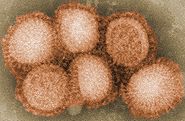Avian influenza: Difference between revisions
Kathrynbyers (talk | contribs) |
Kathrynbyers (talk | contribs) |
||
| Line 6: | Line 6: | ||
==Characteristics of the host== | ==Characteristics of the host== | ||
Avian influenza affects a variety of species. There are three types of this virus, type A, type B, and type C. Type A affects a range of animals including, but not limited to domesticated birds, such as chicken and turkey, wild birds, including ducks, gulls, and seabirds, mammals, such as horses, swine, and humans. Type B and C only affect humans. | Avian influenza affects a variety of species. There are three types of this virus, type A, type B, and type C. Type A affects a range of animals including, but not limited to domesticated birds, such as chicken and turkey, wild birds, including ducks, gulls, and seabirds, mammals, such as horses, swine, and humans. Type B and C only affect humans. | ||
[[File:H1N1 navbox.jpg|thumb| Avian Influenza [http://en.wikipedia.org/wiki/File:H1N1_navbox.jpg CDC]]] | [[File:H1N1 navbox.jpg|thumb| Avian Influenza [http://en.wikipedia.org/wiki/File:H1N1_navbox.jpg CDC]]] | ||
Revision as of 18:50, 4 December 2011
Ex. [[]]
Characteristics of the symbiont/pathogen
Avian influenza is part of the Orthomyxoviridae group, which are single-stranded RNA viruses. There is a viral envelope that encases the surface proteins: Hemagglutinin (HA) and Neuraminidase (NA) and Matrix 2 (M2). There are 15 HA subtypes that are the virus receptor-binding site and also allow the viral RNA to be released into the host cell. The HA protein has to grow into the HA1 and HA2 subunits to be infectious. There are two different classifications of avian influenza, highly pathogenic avian influenza (HPIA) and mildly or non-pathogenic avian influenza (MPIA). The starting place of the virus varies in HPIA and MPAI. In HPIA the HA proteins start in most of the cells in the body of the host and in MPIA the HA proteins start in the respiratory and enteric tracts of the host. There are nine NA subtypes that are enzymatically active proteins that allow the virus to be released from the cell surface. The M2 proteins are an ion channel that activate the HA proteins to release the virus.
Inside these surface proteins, there are six internal proteins that make up the viral genome and transcribe the virus. These proteins include: polymerase proteins, PB, PB1, and PA, the nucleoprotein (NP), matrix 1 (M1), and nonstructural protein 1 and 2 (NS1 and NS2). NS1 is the only protein not located inside the virion.
Characteristics of the host
Avian influenza affects a variety of species. There are three types of this virus, type A, type B, and type C. Type A affects a range of animals including, but not limited to domesticated birds, such as chicken and turkey, wild birds, including ducks, gulls, and seabirds, mammals, such as horses, swine, and humans. Type B and C only affect humans.

Host-Symbiont Interaction
What kind of interaction do host and symbiont have? How is the host affected by the relationship? How does the host acquire and transmit the symbiont? Is the interaction obligate or facultative?
Molecular Insights into the Symbiosis
Describe molecular/genetic studies on the symbiosis.
Ecological and Evolutionary Aspects
What is the evolutionary history of the interaction? Do particular environmental factors play a role in regulating the symbiosis?
Recent Discoveries
Describe two findings on the symbiosis published within the last two years.
References
[1] Suarez, D. L., and Schultz-Cherry, S. 2000. Immunology of avian influenza virus: a review. "Developmental and Comparative Immunology." 24:269-283.
Edited by Nikki Byers, students of Grace Lim-Fong
